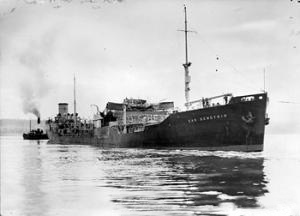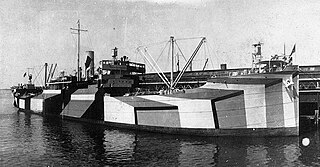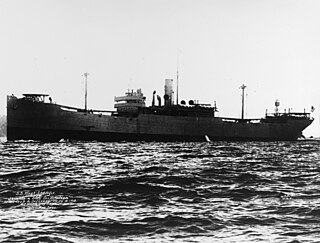
The HX convoys were a series of North Atlantic convoys which ran during the Battle of the Atlantic in the Second World War. They were east-bound convoys and originated in Halifax, Nova Scotia from where they sailed to ports in the United Kingdom. They absorbed the BHX convoys from Bermuda en route. Later, after the United States entered the war, HX convoys began at New York.

This is a timeline for the Battle of the Atlantic (1939–1945) in World War II.

MV San Demetrio was a British motor tanker, notable for her service during the Second World War. She was built in 1938 for the Eagle Oil and Shipping Company. In 1940 she was damaged by enemy action in mid-Atlantic, abandoned by her crew but later re-boarded and successfully brought into harbour. She was the subject of a 1943 feature film, San Demetrio London, one of the few films that recognised the heroism of the UK Merchant Navy crews during the War.

SS Timothy Bloodworth was a standard Liberty ship built for the United States Maritime Commission during World War II. The vessel was built by Delta Shipbuilding Company of New Orleans in 1943. She was named in honor of Timothy Bloodworth, an American teacher who made muskets and bayonets during the American Revolutionary War, then went on to become a statesman in North Carolina.

German submarine U-99 was a Type VIIB U-boat of Nazi Germany's Kriegsmarine during World War II. She was laid down on 31 March 1939 at the Friedrich Krupp Germaniawerft in Kiel as yard number 593. She was launched on 12 March 1940 under the command of Korvettenkapitän Otto Kretschmer and was assigned to the 7th U-boat Flotilla based in Kiel and later in St Nazaire.

SS George Washington Carver was a Liberty ship built for the United States Maritime Commission during World War II. The ship was named in honor of George Washington Carver, and was the second Liberty ship named for an African American.
SS Andrew Furuseth was a Liberty ship built for the United States Maritime Commission during World War II. The ship was named in honor of American merchant seaman and labor organizer Andrew Furuseth. The ship was assigned by the War Shipping Administration to Matson Navigation Company who operated it throughout the war in the Atlantic and Mediterranean. Andrew Furuseth was one of 220 Liberty ships converted to carry a limited number of troops or prisoners of war.

Convoy SC 118 was the 118th of the numbered series of World War II slow convoys of merchant ships from Sydney, Cape Breton Island, to Liverpool. The ships departed New York City on 24 January 1943 and were met by Mid-Ocean Escort Force Group B-2 consisting of V-class destroyers Vanessa and Vimy, the Treasury-class cutter Bibb, the Town-class destroyer Beverley, Flower-class corvettes Campanula, Mignonette, Abelia and Lobelia, and the convoy rescue ship Toward.

The SS Empire Miniver was a British steam merchant ship. She was originally an American merchant, launched in 1918 as SS West Cobalt. During a brief stint in the United States Navy in 1919, she was known as USS West Cobalt (ID-3836).

SS West Nohno was a cargo ship of the United States Shipping Board (USSB) launched shortly after the end of World War I. The ship was inspected by the United States Navy for possible use as USS West Nohno (ID-4029) but was neither taken into the Navy nor ever commissioned under that name.

SS Empire Simba was a British steam-powered cargo ship. She was originally an American ship, launched in 1918 as SS West Cohas. During a stint in the United States Navy from 1918 to 1919, she was called USS West Cohas (ID-3253).

USS West Lianga (ID-2758) was a cargo ship for the United States Navy during World War I. She was later known as SS Helen Whittier and SS Kalani in civilian service under American registry, as SS Empire Cheetah under British registry, and as SS Hobbema under Dutch registry.

USS West Ekonk (ID-3313) was a cargo ship for the United States Navy during World War I. She was later known as SS West Ekonk in civilian service under American registry, and as SS Empire Wildebeeste under British registry.
Empire Airman was a 9,813 ton tanker that was built in 1941. She was renamed San Wenceslao in 1946 and served until 1959 when she was scrapped.
Empire Amethyst was an 8,032-ton tanker which was built in 1941. She was torpedoed and sunk by German submarine U-154 on 13 April 1942.

SS Ocean Vigour was a British Ocean class freighter, which served on various convoys during World War II, and then as a troopship before being used to deport illegal Jewish immigrants who attempted to enter Mandate Palestine to internment camps in Cyprus. She took part in the return of immigrants from the SS Exodus back to Europe, before being sold into commercial service. She was scrapped in 1967.
Belgian Airman was a 6,959-ton cargo ship which was built by Harland & Wolff Ltd, Glasgow in 1941 for the Ministry of War Transport (MoWT). She was launched as Empire Ballantyne and transferred to the Belgian Government in 1942. She was sunk by a German U-boat on 14 April 1945.
SS Vigrid was a Norwegian steam-powered cargo ship built in 1915. Sailing during the First World War, she was torpedoed and sunk without warning by a German U-boat on 31 December 1917.
SS Norse Lady was a cargo ship built by Wood, Skinner and Company of Newcastle upon Tyne to the United Kingdom's standard First World War "War C" design. She traded from 1920 until 1958, in which time she had six successive owners and four different names. In 1958 she ran aground in eastern Indonesia, was captured and beached by rebels, and then set on fire by a naval bombardment. She remained a wreck until 1966, when she was scrapped in Taiwan.
SS Maasdam was a Dutch turbine steamship that was launched in 1920 and sunk in 1941. She was the third Holland America Line ship to be named after the village of Maasdam in South Holland.












